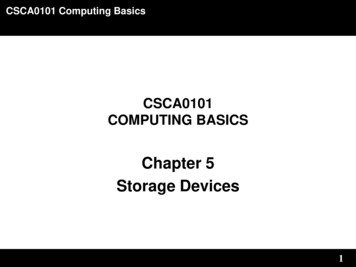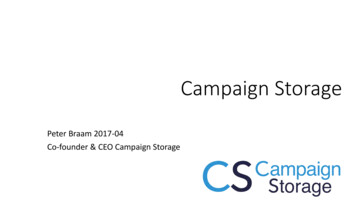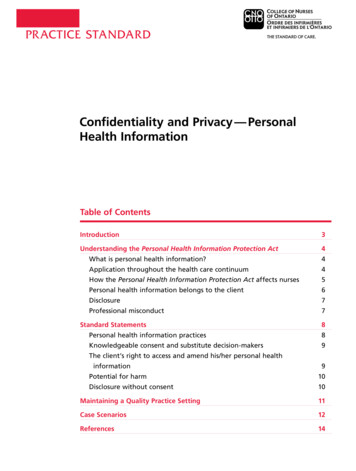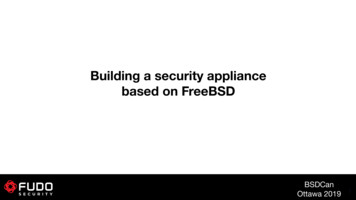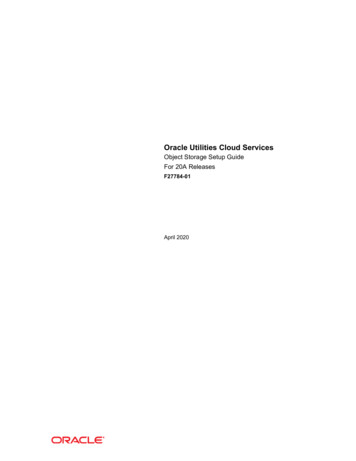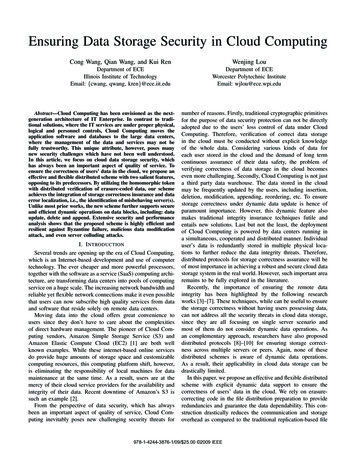
Transcription
Ensuring Data Storage Security in Cloud ComputingCong Wang, Qian Wang, and Kui RenWenjing LouDepartment of ECEIllinois Institute of TechnologyEmail: {cwang, qwang, kren}@ece.iit.eduDepartment of ECEWorcester Polytechnic InstituteEmail: wjlou@ece.wpi.eduAbstract—Cloud Computing has been envisioned as the nextgeneration architecture of IT Enterprise. In contrast to traditional solutions, where the IT services are under proper physical,logical and personnel controls, Cloud Computing moves theapplication software and databases to the large data centers,where the management of the data and services may not befully trustworthy. This unique attribute, however, poses manynew security challenges which have not been well understood.In this article, we focus on cloud data storage security, whichhas always been an important aspect of quality of service. Toensure the correctness of users’ data in the cloud, we propose aneffective and flexible distributed scheme with two salient features,opposing to its predecessors. By utilizing the homomorphic tokenwith distributed verification of erasure-coded data, our schemeachieves the integration of storage correctness insurance and dataerror localization, i.e., the identification of misbehaving server(s).Unlike most prior works, the new scheme further supports secureand efficient dynamic operations on data blocks, including: dataupdate, delete and append. Extensive security and performanceanalysis shows that the proposed scheme is highly efficient andresilient against Byzantine failure, malicious data modificationattack, and even server colluding attacks.I. I NTRODUCTIONSeveral trends are opening up the era of Cloud Computing,which is an Internet-based development and use of computertechnology. The ever cheaper and more powerful processors,together with the software as a service (SaaS) computing architecture, are transforming data centers into pools of computingservice on a huge scale. The increasing network bandwidth andreliable yet flexible network connections make it even possiblethat users can now subscribe high quality services from dataand software that reside solely on remote data centers.Moving data into the cloud offers great convenience tousers since they don’t have to care about the complexitiesof direct hardware management. The pioneer of Cloud Computing vendors, Amazon Simple Storage Service (S3) andAmazon Elastic Compute Cloud (EC2) [1] are both wellknown examples. While these internet-based online servicesdo provide huge amounts of storage space and customizablecomputing resources, this computing platform shift, however,is eliminating the responsibility of local machines for datamaintenance at the same time. As a result, users are at themercy of their cloud service providers for the availability andintegrity of their data. Recent downtime of Amazon’s S3 issuch an example [2].From the perspective of data security, which has alwaysbeen an important aspect of quality of service, Cloud Computing inevitably poses new challenging security threats fornumber of reasons. Firstly, traditional cryptographic primitivesfor the purpose of data security protection can not be directlyadopted due to the users’ loss control of data under CloudComputing. Therefore, verification of correct data storagein the cloud must be conducted without explicit knowledgeof the whole data. Considering various kinds of data foreach user stored in the cloud and the demand of long termcontinuous assurance of their data safety, the problem ofverifying correctness of data storage in the cloud becomeseven more challenging. Secondly, Cloud Computing is not justa third party data warehouse. The data stored in the cloudmay be frequently updated by the users, including insertion,deletion, modification, appending, reordering, etc. To ensurestorage correctness under dynamic data update is hence ofparamount importance. However, this dynamic feature alsomakes traditional integrity insurance techniques futile andentails new solutions. Last but not the least, the deploymentof Cloud Computing is powered by data centers running ina simultaneous, cooperated and distributed manner. Individualuser’s data is redundantly stored in multiple physical locations to further reduce the data integrity threats. Therefore,distributed protocols for storage correctness assurance will beof most importance in achieving a robust and secure cloud datastorage system in the real world. However, such important arearemains to be fully explored in the literature.Recently, the importance of ensuring the remote dataintegrity has been highlighted by the following researchworks [3]–[7]. These techniques, while can be useful to ensurethe storage correctness without having users possessing data,can not address all the security threats in cloud data storage,since they are all focusing on single server scenario andmost of them do not consider dynamic data operations. Asan complementary approach, researchers have also proposeddistributed protocols [8]–[10] for ensuring storage correctness across multiple servers or peers. Again, none of thesedistributed schemes is aware of dynamic data operations.As a result, their applicability in cloud data storage can bedrastically limited.In this paper, we propose an effective and flexible distributedscheme with explicit dynamic data support to ensure thecorrectness of users’ data in the cloud. We rely on erasurecorrecting code in the file distribution preparation to provideredundancies and guarantee the data dependability. This construction drastically reduces the communication and storageoverhead as compared to the traditional replication-based file978-1-4244-3876-1/09/ 25.00 2009 IEEE
distribution techniques. By utilizing the homomorphic tokenwith distributed verification of erasure-coded data, our schemeachieves the storage correctness insurance as well as dataerror localization: whenever data corruption has been detectedduring the storage correctness verification, our scheme canalmost guarantee the simultaneous localization of data errors,i.e., the identification of the misbehaving server(s).Our work is among the first few ones in this field to considerdistributed data storage in Cloud Computing. Our contributioncan be summarized as the following three aspects:1) Compared to many of its predecessors, which only providebinary results about the storage state across the distributedservers, the challenge-response protocol in our work furtherprovides the localization of data error.2) Unlike most prior works for ensuring remote data integrity,the new scheme supports secure and efficient dynamic operations on data blocks, including: update, delete and append.3) Extensive security and performance analysis shows thatthe proposed scheme is highly efficient and resilient againstByzantine failure, malicious data modification attack, and evenserver colluding attacks.The rest of the paper is organized as follows. Section IIintroduces the system model, adversary model, our design goaland notations. Then we provide the detailed description of ourscheme in Section III and IV. Section V gives the securityanalysis and performance evaluations, followed by Section VIwhich overviews the related work. Finally, Section VII givesthe concluding remark of the whole paper.II. P ROBLEM S TATEMENTA. System ModelA representative network architecture for cloud data storageis illustrated in Figure 1. Three different network entities canbe identified as follows: User: users, who have data to be stored in the cloud andrely on the cloud for data computation, consist of bothindividual consumers and organizations. Cloud Service Provider (CSP): a CSP, who has significant resources and expertise in building and managingdistributed cloud storage servers, owns and operates liveCloud Computing systems. Third Party Auditor (TPA): an optional TPA, who hasexpertise and capabilities that users may not have, istrusted to assess and expose risk of cloud storage serviceson behalf of the users upon request.In cloud data storage, a user stores his data through a CSPinto a set of cloud servers, which are running in a simultaneous, cooperated and distributed manner. Data redundancycan be employed with technique of erasure-correcting codeto further tolerate faults or server crash as user’s data growsin size and importance. Thereafter, for application purposes,the user interacts with the cloud servers via CSP to access orretrieve his data. In some cases, the user may need to performblock level operations on his data. The most general forms ofSMe s e cu ritysage Flowrit y lowcu FSe ages s Optional Third Party AuditoreMCloudStorageServersData FlowUsersSecurity Message FlowCloud Service ProviderFig. 1: Cloud data storage architecturethese operations we are considering are block update, delete,insert and append.As users no longer possess their data locally, it is of criticalimportance to assure users that their data are being correctlystored and maintained. That is, users should be equipped withsecurity means so that they can make continuous correctnessassurance of their stored data even without the existence oflocal copies. In case that users do not necessarily have thetime, feasibility or resources to monitor their data, they candelegate the tasks to an optional trusted TPA of their respectivechoices. In our model, we assume that the point-to-pointcommunication channels between each cloud server and theuser is authenticated and reliable, which can be achieved inpractice with little overhead. Note that we don’t address theissue of data privacy in this paper, as in Cloud Computing,data privacy is orthogonal to the problem we study here.B. Adversary ModelSecurity threats faced by cloud data storage can comefrom two different sources. On the one hand, a CSP canbe self-interested, untrusted and possibly malicious. Not onlydoes it desire to move data that has not been or is rarelyaccessed to a lower tier of storage than agreed for monetaryreasons, but it may also attempt to hide a data loss incidentdue to management errors, Byzantine failures and so on.On the other hand, there may also exist an economicallymotivated adversary, who has the capability to compromisea number of cloud data storage servers in different timeintervals and subsequently is able to modify or delete users’data while remaining undetected by CSPs for a certain period.Specifically, we consider two types of adversary with differentlevels of capability in this paper:Weak Adversary: The adversary is interested in corrupting theuser’s data files stored on individual servers. Once a server iscomprised, an adversary can pollute the original data files bymodifying or introducing its own fraudulent data to preventthe original data from being retrieved by the user.Strong Adversary: This is the worst case scenario, in whichwe assume that the adversary can compromise all the storageservers so that he can intentionally modify the data files aslong as they are internally consistent. In fact, this is equivalentto the case where all servers are colluding together to hide adata loss or corruption incident.
C. Design GoalsTo ensure the security and dependability for cloud datastorage under the aforementioned adversary model, we aimto design efficient mechanisms for dynamic data verificationand operation and achieve the following goals: (1) Storagecorrectness: to ensure users that their data are indeed storedappropriately and kept intact all the time in the cloud. (2)Fast localization of data error: to effectively locate the malfunctioning server when data corruption has been detected. (3)Dynamic data support: to maintain the same level of storagecorrectness assurance even if users modify, delete or appendtheir data files in the cloud. (4) Dependability: to enhance dataavailability against Byzantine failures, malicious data modification and server colluding attacks, i.e. minimizing the effectbrought by data errors or server failures. (5) Lightweight:to enable users to perform storage correctness checks withminimum overhead.D. Notation and Preliminaries F – the data file to be stored. We assume that F can bedenoted as a matrix of m equal-sized data vectors, eachconsisting of l blocks. Data blocks are all well representedas elements in Galois Field GF (2p ) for p 8 or 16.A – The dispersal matrix used for Reed-Solomon coding.G – The encoded file matrix, which includes a set ofn m k vectors, each consisting of l blocks.fkey (·) – pseudorandom function (PRF), which is definedas f : {0, 1} key GF (2p ).φkey (·) – pseudorandom permutation (PRP), which isdefined as φ : {0, 1}log2 (l) key {0, 1}log2 (l) .ver – a version number bound with the index for individual blocks, which records the times the block has beenmodified. Initially we assume ver is 0 for all data blocks.sverij – the seed for PRF, which depends on the file name,block index i, the server position j as well as the optionalblock version number ver.III. E NSURING C LOUD DATA S TORAGEIn cloud data storage system, users store their data inthe cloud and no longer possess the data locally. Thus, thecorrectness and availability of the data files being stored on thedistributed cloud servers must be guaranteed. One of the keyissues is to effectively detect any unauthorized data modification and corruption, possibly due to server compromise and/orrandom Byzantine failures. Besides, in the distributed casewhen such inconsistencies are successfully detected, to findwhich server the data error lies in is also of great significance,since it can be the first step to fast recover the storage errors.To address these problems, our main scheme for ensuringcloud data storage is presented in this section. The first part ofthe section is devoted to a review of basic tools from codingtheory that are needed in our scheme for file distribution acrosscloud servers. Then, the homomorphic token is introduced.The token computation function we are considering belongsto a family of universal hash function [11], chosen to preserve the homomorphic properties, which can be perfectlyintegrated with the verification of erasure-coded data [8] [12].Subsequently, it is also shown how to derive a challengeresponse protocol for verifying the storage correctness as wellas identifying misbehaving servers. Finally, the procedure forfile retrieval and error recovery based on erasure-correctingcode is outlined.A. File Distribution PreparationIt is well known that erasure-correcting code may be usedto tolerate multiple failures in distributed storage systems. Incloud data storage, we rely on this technique to disperse thedata file F redundantly across a set of n m k distributedservers. A (m k, k) Reed-Solomon erasure-correcting codeis used to create k redundancy parity vectors from m datavectors in such a way that the original m data vectors can bereconstructed from any m out of the m k data and parityvectors. By placing each of the m k vectors on a differentserver, the original data file can survive the failure of any k ofthe m k servers without any data loss, with a space overheadof k/m. For support of efficient sequential I/O to the originalfile, our file layout is systematic, i.e., the unmodified m datafile vectors together with k parity vectors is distributed acrossm k different servers.Let F (F1 , F2 , . . . , Fm ) and Fi (f1i , f2i , . . . , fli )T(i {1, . . . , m}), where l 2p 1. Note all these blocksare elements of GF (2p ). The systematic layout with parityvectors is achieved with the information dispersal matrix A,derived from an m (m k) Vandermonde matrix [13]: 11.11.1 β1β2.βmβm 1 . . .βn , . .β1m 1β2m 1.m 1βmm 1βm 1.βnm 1where βj (j {1, . . . , n}) are distinct elements randomlypicked from GF (2p ).After a sequence of elementary row transformations, thedesired matrix A can be written as 1 0 . . . 0 p11 p12 . . . p1k 0 1 . . . 0 p21 p22 . . . p2k A (I P) . . . ,. . . . . 0 0 . . . 1 pm1 pm2 . . . pmkwhere I is a m m identity matrix and P is the secret paritygeneration matrix with size m k. Note that A is derivedfrom a Vandermonde matrix, thus it has the property that anym out of the m k columns form an invertible matrix.By multiplying F by A, the user obtains the encoded file:G F·A (G(1) , G(2) , . . . , G(m) , G(m 1) , . . . , G(n) ) (F1 , F2 , . . . , Fm , G(m 1) , . . . , G(n) ),(j)(j)(j)where G(j) (g1 , g2 , . . . , gl )T (j {1, . . . , n}). Asnoticed, the multiplication reproduces the original data filevectors of F and the remaining part (G(m 1) , . . . , G(n) ) arek parity vectors generated based on F.
Algorithm 1 Token Pre-computation1: procedure2:Choose parameters l, n and function f, φ;3:Choose the number t of tokens;4:Choose the number r of indices per verification;5:Generate master key Kprp and challenge kchal ;6:for vector G(j) , j 1, n do7:for round i 1, t do(i)8:Derive αi fkchal (i) and kprp from KP RP . (j)r9:Compute vi q 1 αiq G(j) [φk(i) (q)]prp10:end for11:end for12:Store all the vi s locally.13: end procedureB. Challenge Token PrecomputationIn order to achieve assurance of data storage correctnessand data error localization simultaneously, our scheme entirelyrelies on the pre-computed verification tokens. The main ideais as follows: before file distribution the user pre-computes acertain number of short verification tokens on individual vectorG(j) (j {1, . . . , n}), each token covering a random subsetof data blocks. Later, when the user wants to make sure thestorage correctness for the data in the cloud, he challengesthe cloud servers with a set of randomly generated blockindices. Upon receiving challenge, each cloud server computesa short “signature” over the specified blocks and returns themto the user. The values of these signatures should match thecorresponding tokens pre-computed by the user. Meanwhile,as all servers operate over the same subset of the indices, therequested response values for integrity check must also be avalid codeword determined by secret matrix P.Suppose the user wants to challenge the cloud servers ttimes to ensure the correctness of data storage. Then, hemust pre-compute t verification tokens for each G(j) (j {1, . . . , n}), using a PRF f (·), a PRP φ(·), a challenge keykchal and a master permutation key KP RP . To generate theith token for server j, the user acts as follows:1) Derive a random challenge value αi of GF (2p ) by αi (i)fkchal (i) and a permutation key kprp based on KP RP .2) Compute the set of r randomly-chosen indices:{Iq [1, ., l] 1 q r}, where Iq φk(i) (q).prp3) Calculate the token as:(j)vir (j)αiq G(j) [Iq ], where G(j) [Iq ] gIq .q 1(j)Note that vi , which is an element of GF (2p ) with smallsize, is the response the user expects to receive from server jwhen he challenges it on the specified data blocks.After token generation, the user has the choice of eitherkeeping the pre-computed tokens locally or storing them inencrypted form on the cloud servers. In our case here, theAlgorithm 2 Correctness Verification and Error Localization1: procedure C HALLENGE (i)(i)2:Recompute αi fkchal (i) and kprp from KP RP ;(i)3:Send {αi , kprp } to all the cloud servers;4:Receive from r servers:(j){Ri q 1 αiq G(j) [φk(i) (q)] 1 j n}prp5:for (j m 1, n) dor6:R(j) R(j) q 1 fkj (sIq ,j )·αiq , Iq φk(i) (q)prp7:end for(1)(m)(m 1)(n)8:if ((Ri , . . . , Ri ) · P (Ri, . . . , Ri )) then9:Accept and ready for the next challenge.10:else11:for (j 1, n) do(j)(j)12:if (Ri ! vi ) then13:return server j is misbehaving.14:end if15:end for16:end if17: end procedureuser stores them locally to obviate the need for encryptionand lower the bandwidth overhead during dynamic data operation which will be discussed shortly. The details of tokengeneration are shown in Algorithm 1.Once all tokens are computed, the final step before(j)infile distribution is to blind each parity block gi(G(m 1) , . . . , G(n) ) by(j)gi(j) gi fkj (sij ), i {1, . . . , l},where kj is the secret key for parity vector G(j) (j {m 1, . . . , n}). This is for protection of the secret matrix P. Wewill discuss the necessity of using blinded parities in detailin Section V. After blinding the parity information, the userdisperses all the n encoded vectors G(j) (j {1, . . . , n})across the cloud servers S1 , S2 , . . . , Sn .C. Correctness Verification and Error LocalizationError localization is a key prerequisite for eliminating errorsin storage systems. However, many previous schemes do notexplicitly consider the problem of data error localization,thus only provide binary results for the storage verification.Our scheme outperforms those by integrating the correctnessverification and error localization in our challenge-responseprotocol: the response values from servers for each challengenot only determine the correctness of the distributed storage,but also contain information to locate potential data error(s).Specifically, the procedure of the i-th challenge-response fora cross-check over the n servers is described as follows:1) The user reveals the αi as well as the i-th permutation(i)key kprp to each servers.2) The server storing vector G(j) aggregates those r rows(i)specified by index kprp into a linear combination(j)Rir q 1αiq G(j) [φk(i) (q)].prp
(j)3) Upon receiving Ri s from all the servers, the user takesaway blind values in R(j) (j {m 1, . . . , n}) by(j)Rir(j)fkj (sIq ,j ) · αiq , where Iq φk(i) (q). Ri prpq 14) Then the user verifies whether the received values remain a valid codeword determined by secret matrix P:(1)(m)(Ri , . . . , Ri?(m 1)) · P (Ri(n), . . . , Ri ).Because all the servers operate over the same subset ofindices, the linear aggregation of these r specified rows(1)(n)(Ri , . . . , Ri ) has to be a codeword in the encoded filematrix. If the above equation holds, the challenge is passed.Otherwise, it indicates that among those specified rows, thereexist file block corruptions.Once the inconsistency among the storage has been successfully detected, we can rely on the pre-computed verificationtokens to further determine where the potential data error(s)(j)lies in. Note that each response Ri is computed exactly in the(j)same way as token vi , thus the user can simply find whichserver is misbehaving by verifying the following n equations:(j) ?Ri(j) vi , j {1, . . . , n}.Algorithm 2 gives the details of correctness verification anderror localization.D. File Retrieval and Error RecoverySince our layout of file matrix is systematic, the user canreconstruct the original file by downloading the data vectorsfrom the first m servers, assuming that they return the correctresponse values. Notice that our verification scheme is basedon random spot-checking, so the storage correctness assuranceis a probabilistic one. However, by choosing system parameters (e.g., r, l, t) appropriately and conducting enough timesof verification, we can guarantee the successful file retrievalwith high probability. On the other hand, whenever the datacorruption is detected, the comparison of pre-computed tokensand received response values can guarantee the identificationof misbehaving server(s), again with high probability, whichwill be discussed shortly. Therefore, the user can alwaysask servers to send back blocks of the r rows specified inthe challenge and regenerate the correct blocks by erasurecorrection, shown in Algorithm 3, as long as there are at mostk misbehaving servers are identified. The newly recoveredblocks can then be redistributed to the misbehaving serversto maintain the correctness of storage.IV. P ROVIDING DYNAMIC DATA O PERATION S UPPORTSo far, we assumed that F represents static or archiveddata. This model may fit some application scenarios, suchas libraries and scientific datasets. However, in cloud datastorage, there are many potential scenarios where data storedin the cloud is dynamic, like electronic documents, photos, orlog files etc. Therefore, it is crucial to consider the dynamiccase, where a user may wish to perform various block-levelAlgorithm 3 Error Recovery1: procedure% Assume the block corruptions have been detectedamong% the specified r rows;% Assume s k servers have been identified misbehaving2:Download r rows of blocks from servers;3:Treat s servers as erasures and recover the blocks.4:Resend the recovered blocks to corresponding servers.5: end procedureoperations of update, delete and append to modify the data filewhile maintaining the storage correctness assurance.The straightforward and trivial way to support these operations is for user to download all the data from the cloud serversand re-compute the whole parity blocks as well as verificationtokens. This would clearly be highly inefficient. In this section,we will show how our scheme can explicitly and efficientlyhandle dynamic data operations for cloud data storage.A. Update OperationIn cloud data storage, sometimes the user may need tomodify some data block(s) stored in the cloud, from itscurrent value fij to a new one, fij Δfij . We refer thisoperation as data update. Due to the linear property of ReedSolomon code, a user can perform the update operation andgenerate the updated parity blocks by using Δfij only, withoutinvolving any other unchanged blocks. Specifically, the usercan construct a general update matrix ΔF as Δf11 Δf12 . . . Δf1m Δf21 Δf22 . . . Δf2m ΔF . . . Δfl1 Δfl2 . . . Δflm(ΔF1 , ΔF2 , . . . , ΔFm ).Note that we use zero elements in ΔF to denote the unchangedblocks. To maintain the corresponding parity vectors as well asbe consistent with the original file layout, the user can multiplyΔF by A and thus generate the update information for boththe data vectors and parity vectors as follows:ΔF · A (ΔG(1) , . . . , ΔG(m) , ΔG(m 1) , . . . , ΔG(n) ) (ΔF1 , . . . , ΔFm , ΔG(m 1) , . . . , ΔG(n) ),where ΔG(j) (j {m 1, . . . , n}) denotes the updateinformation for the parity vector G(j) .Because the data update operation inevitably affects someor all of the remaining verification tokens, after preparation ofupdate information, the user has to amend those unused tokensfor each vector G(j) to maintain the same storage correctnessassurance. In other words, for all the unused tokens, the userneeds to exclude every occurrence of the old data block andreplace it with the new one. Thanks to the homomorphicconstruction of our verification token, the user can performthe token update efficiently. To give more details, suppose a
(j)block G(j) [Is ], which is covered by the specific token vi , hasbeen changed to G(j) [Is ] ΔG(j) [Is ], where Is φk(i) (s).prp(j)To maintain the usability of token vi , it is not hard to verifythat the user can simply update it by(j)vi(j) vi αis ΔG(j) [Is ],without retrieving any other r 1 blocks required in the pre(j)computation of vi .After the amendment to the affected tokens1 , the user needs(j)to blind the update information Δgi for each parity block in(ΔG(m 1) , . . . , ΔG(n) ) to hide the secret matrix P by(j)Δgi (j)Δgi fkj (sverij ), iG G(j)(j) ΔG, (j {1, . . . , n}).B. Delete OperationSometimes, after being stored in the cloud, certain datablocks may need to be deleted. The delete operation we areconsidering is a general one, in which user replaces the datablock with zero or some special reserved data symbol. Fromthis point of view, the delete operation is actually a special caseof the data update operation, where the original data blockscan be replaced with zeros or some predetermined specialblocks. Therefore, we can rely on the update procedure tosupport delete operation, i.e., by setting Δfij in ΔF to be Δfij . Also, all the affected tokens have to be modified andthe updated parity information has to be blinded using thesame method specified in update operation.C. Append OperationIn some cases, the user may want to increase the size ofhis stored data by adding blocks at the end of the data file,which we refer as data append. We anticipate that the mostfrequent append operation in cloud data storage is bulk append,in which the user needs to upload a large number of blocks(not a single block) at one time.Given the file matrix F illustrated in file distribution preparation, appending blocks towards the end of a data file isequivalent to concatenate corresponding rows at the bottomof the matrix layout for file F. In the beginning, there areonly l rows in the file matrix. To simplify the presentation,we suppose the user wants to append m blocks at the end offile F, denoted as (fl 1,1 , fl 1,2 , ., fl 1,m ) (We can alwaysuse zero-padding to make a row of m elements.). With thesecret matrix P, the user can directly calculate the appendblocks for each parity server as(m 1)(fl 1,1 , ., fl 1,m ) · P (gl 11 Inrmaxvi {1, . . . , l}.Here we use a new seed sverij for the PRF. The version numberver functions like a counter which helps the user to keeptrack of the blind information on the specific parity blocks.After blinding, the user sends update information to the cloudservers, which perform the update operation as(j)To support block append operation, we need a slight modification to our token pre-computation. Specifically, we requirethe user to expect the maximum size in blocks, denoted aslmax , for each of his data vector. The idea of supportingblock append, which is similar as adopted in [7], relies onthe initial budget for the maximum anticipated data size lmaxin each encoded data vector as well as the system parameterrmax r (lmax /l) for each pre-computed challengeresponse token. The pre-computation of the i-th token onserver j is modified as follows:(n), ., gl 1 ).practice, it is possible that only a fraction of tokens need amendment,since the updated blocks may not be covered by all the tokens.αiq G(j) [Iq ],q 1whereG(j) [Iq ] G(j) [φk(i) (q)], [φk(i) (q)] l0, [φk(i) (q)] lprpprpprpThis formula guarant
rely on the cloud for data computation, consist of both individual consumers and organizations. Cloud Service Provider (CSP): a CSP, who has signif-icant resources and expertise in building and managing distributed cloud storage servers, owns and operates live Cloud Computing systems. Third Party Auditor (TPA): an optional TPA, who has
